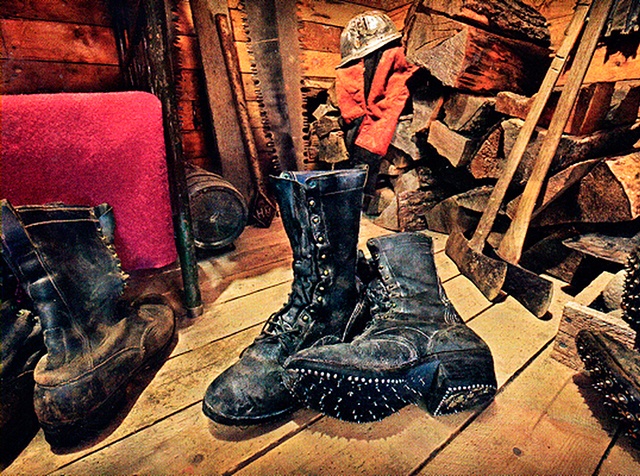Sometimes those raised in rural Olympic Peninsula areas just have to get a logging fix now that so many of the areas have turned into places for urban folks. The woods and logging shows are to the rural areas what shopping malls are to urbanity. The Forks Timber Museum is one spot to get in touch with rural logging heritage.
It is a daylong adventure that is best to be enjoyed almost on the hoot owl shift of early morning to take in all of the sights of managed forests in all stages from new logging cuts, to multi-stands of mixed species, Douglas fir, and those ready for the next harvest. From the Grays Harbor area, the trip of 110 miles isn’t measured in the destination but in the journey, especially during the tourist traffic season. But, what are a few slow trailers or RVs when one can see the forest topped by the Olympic range of mountains?
Log rafting sites
From the core area of Grays Harbor northward on U.S. 101, the views of bygone log rafting sites in streams is a delight for the photographer and brings back the memories of boom men dancing over the log rafts. Those coming from the North Beach areas have two choices for scenic driving – either through the Kirkpatrick from Copalis and Copalis Crossing through the old Rayonier logging camp areas, or the Moclips Highway through the Cook Creek area of the Quinault Indian Reservation to U.S. 101. The former takes in the famous Section 21 that has been producing lumber since the mid-1800s. The latter is the land of Polson and Rayonier Company’s rail lines.
Lake Quinault Museum
By the time the South Lake Quinault road comes into view, it just may be time to stop for a coffee and peruse the Lake Quinault Museum housed in the former (1918) Quinault Post Office on the South Shore Road. It may be small, but it is an absolute gem of history. For the timber folks, the variety of logging and shake dioramas are delights to behold. But one must not linger because the Forks Museum awaits.
A bonus on the trip is views of the Pacific Ocean portion of the Olympic National Park’s 73-mile coastline, especially north of the Kalaloch area where the historic Destruction Island can be seen. On the way home, if the tide is low, plan a stop at Ruby Beach to explore the tide pools at this breathtaking area about 45 minutes from Forks.
Forks museum treasures
You can’t miss the Forks Timber Museum grounds at the outskirts of town. On the left is the airport; on the right is the Museum complex at 1421 S. Forks Avenue right on US101. The Forks Timber museum is open daily at 10 a.m. Parking is available with large vehicle parking available on the southern portion of the property.
Inside the two-story museum, built by the Forks High School carpentry shop class and volunteers in 1989, is a plethora of artifacts fulfilling the museum’s mission of “Heritage of the past preserved for the future.” The size of a logging camp cook stove sets the scale for the size of the crews that worked in the camps. Photographs abound from early days to the boom days of the 1970s when the town’s population doubled to over 3,000 that decade when it was labeled the “Logging Capitol of the World.”
Displays from homestead days to World War I spruce logging are focused on the 36 miles of railroad track built in 1918 from Port Angeles to Lake Pleasant at the Sappho/Beaver areas. The great blowdown on 1921, the 1951 Forks fire, and the Columbus Day storm of 1962 are brackets by logging show dioramas, a huge display of chainsaws, small tools and more.
A sobering, yet a wonderful salute to loggers known throughout the old time, large Peninsula community of gyppo and corporate log company loggers is the excellent loggers’ memorial on the north side of the complex.
This is a place that records names, occupations and obituaries of loggers. It is a quiet place to contemplate the occupation that required amazing sets of skills and the guts to work in dangerous conditions. While it may bring a tear to the eye when a name is familiar, it also brings laughter, as no one can be a greater character than a logger.
Logging tour
During the summer on Wednesdays a tour of logging sites and a local mill is available through the reservation system of the Chamber of Commerce by calling ahead to 360- 374-2531. The excellent, well-trained, friendly staff at the visitor information center on the museum grounds is chock full of information for more places to plan return trips for multiple activities and, of course, the Twilight Tours. Bella’s truck is parked right outside to take your photo bragging rights.
The Floyd M. Thorton Nature Trail in the Centennial Grove to the south of the museum and the Olympic Natural Resource Loop offer peaceful places to stretch your legs.
But, for the true logging aficionado, it is the amazing logging equipment stored in the woods to the south of the swamp works. Can you believe, awaiting to be resurrected are an eight-foot long, bladed, tracked Cat, an old flatbed with iron rimmed tires, a lumber carrier, portions of a Skagit tower, a set of massive tongs, an 1833 patented logging arch and a 1929 Hyster straddle truck and more to touch, feel and get your fill of a logging fix?
Such a deal. Such a trip. And it is only 110 miles back home.
More info
www.forkswa.com; info@forkswa.com; 1-800-443-6757 or on Facebook.com/forkswa
Lake Quinault Museum info: 360/288-2583 or 288-2317 and at: www.QuinaultRainForest.com
Gene Woodwick can be reached at genewoodwick@coastaccess.com or by telephone at 360/289-2805.


